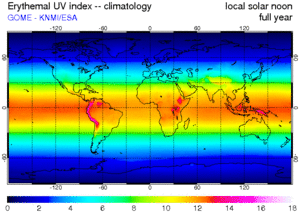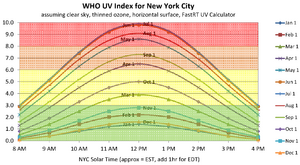Ultraviolet index facts for kids
The ultraviolet index, or UV index, is a special measurement that tells you how strong the sun's ultraviolet (UV) rays are at a certain time and place. It's like a warning system to help you know when to protect your skin from the sun. The UV index uses a simple number scale. A higher number means the UV rays are stronger and can cause sunburn faster.
The main goal of the UV index is to help people stay safe from too much sun. While a little sun is good for you, too much can cause problems like sunburn, skin aging, damage to your DNA, skin cancer, and even eye damage like cataracts.
Scientists in Canada created this scale in 1992. Then, big organizations like the World Health Organization (WHO) and the World Meteorological Organization (WMO) made it a worldwide standard in 1994. Health experts suggest you protect yourself (like using sunscreen or wearing a hat and sunglasses) if the UV index is 3 or higher.
Contents
What is the UV Index?
The UV index is a simple number scale that shows how strong the sun's UV rays are. It's all about how quickly those rays can cause a sunburn. For example, if the UV index is 12, the sun's rays are twice as strong as when the index is 6. This means you could get a sunburn in half the time!
The UV index is different from other scales you might know, like the Richter scale for earthquakes. Those scales often multiply in severity, but the UV index is a straight line. If the number doubles, the strength of the UV rays doubles.
- UV Index 0: This means there are no UV rays, like at night.
- UV Index 10: This used to be the highest number for strong midday summer sun in tropical places. Now, because of things like less ozone in the atmosphere, you can see numbers higher than 10, especially in mountains or near reflective surfaces like snow or water.
How is the UV Index Predicted?
You might see the UV index in weather reports. This number is usually a prediction made by computers. These computers use lots of information to figure out how strong the UV rays will be. They look at:
- How far the Earth is from the sun.
- How high the sun is in the sky.
- How much ozone is in the atmosphere (ozone helps block UV rays).
- How much dust or pollution is in the air.
- How high up you are (UV is stronger at higher elevations).
- If there's snow or water that can reflect the sun's rays.
- How many clouds are in the sky.
The daily UV index usually tells you about the UV strength around solar noon. This is when the sun is highest in the sky, usually between 11:30 AM and 1:30 PM, depending on daylight saving time. Even if the prediction isn't perfect, it's usually very close to what you would actually measure.
History of the UV Index
The modern UV index was created by three Canadian scientists: James B. Kerr, C. Thomas McElroy, and David I. Wardle. They invented it in Toronto, Ontario. Canada was the first country to start giving official UV level predictions in weather forecasts on May 27, 1992.
At first, different countries had their own ways of calculating and reporting the UV index. But in 1994, the World Health Organization and the World Meteorological Organization made it a worldwide standard. This meant everyone used the same way to calculate it and even used the same colors and pictures for weather reports.
In 2003, a very high UV index of 43.3 was recorded at the Licancabur volcano in Bolivia. This was a world record for ground-level UV!
In 2005, Australia and the United States started something called the "UV Alert." This alert helps people know when the sun's UV rays are very strong so they can protect themselves.
The scientists who invented the UV index, Kerr, McElroy, and Wardle, were honored in 2007 by the United Nations for their important work. Also in 2007, the UV index was ranked as one of the "100 Biggest Weather Moments" by The Weather Channel!
In 2022, the WHO and other groups launched a new phone app. This app gives you local information about UV radiation levels to help you stay safe.
How to Use the UV Index
The advice below is for average adults with lightly tanned skin. If you have darker skin, you might be able to handle more sun. But children, older people, very fair-skinned adults, or anyone who is extra sensitive to the sun needs to be even more careful!
Here's what the different UV index numbers mean and how you can protect yourself:
| UV index | Color | Risk from Sun Exposure | Recommended Protection |
|---|---|---|---|
| 0 - 2 | Green | Low | There's a low danger from the sun's UV rays for most people.
|
| 3 - 5 | Yellow | Moderate | There's a moderate risk of harm from sun exposure.
|
| 6 - 7 | Orange | High | There's a high risk of harm from sun exposure. You need to protect your skin and eyes.
|
| 8 - 10 | Red | Very high | There's a very high risk of harm from sun exposure. Be extra careful because your skin and eyes can get damaged and burn quickly.
|
| 11+ | Violet | Extreme | There's an extreme risk of harm from sun exposure. Take all possible steps to protect yourself because your skin and eyes can burn in minutes.
|
Some apps for phones can use the UV index and your skin type to guess how long you can stay in the sun before you might get a sunburn.
Images for kids
See also
- Health effects of sunlight exposure
- Sun protective clothing
- Sunscreen




